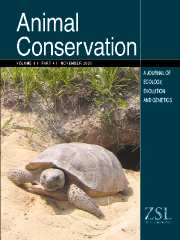Crossref Citations
This article has been cited by the following publications. This list is generated based on data provided by
Crossref.
Shankar, T. R.
and
Mudappa, Divya
2003.
Bridging the gap: Sharing responsibility for ecological restoration and wildlife conservation on private lands in the Western Ghats.
Social Change,
Vol. 33,
Issue. 2-3,
p.
129.
Sodhi, Navjot S.
Liow, L.H.
and
Bazzaz, F.A.
2004.
Avian Extinctions from Tropical and Subtropical Forests.
Annual Review of Ecology, Evolution, and Systematics,
Vol. 35,
Issue. 1,
p.
323.
HILL, JANE K.
and
HAMER, KEITH C.
2004.
Determining impacts of habitat modification on diversity of tropical forest fauna: the importance of spatial scale.
Journal of Applied Ecology,
Vol. 41,
Issue. 4,
p.
744.
Adeney, J.M.
Ginsberg, J. R.
Russell, G. J.
and
Kinnaird, M. F.
2006.
Effects of an ENSO‐related fire on birds of a lowland tropical forest in Sumatra.
Animal Conservation,
Vol. 9,
Issue. 3,
p.
292.
Raman, T. R. Shankar
2006.
Forest Diversity and Management.
p.
517.
Renner, Swen C
Waltert, Matthias
and
Mühlenberg, Michael
2006.
Forest Diversity and Management.
p.
485.
Raman, T. R. Shankar
2006.
Effects of Habitat Structure and Adjacent Habitats on Birds in Tropical Rainforest Fragments and Shaded Plantations in the Western Ghats, India.
Biodiversity and Conservation,
Vol. 15,
Issue. 4,
p.
1577.
Renner, Swen C
Waltert, Matthias
and
Mühlenberg, Michael
2006.
Comparison of Bird Communities in Primary vs. Young Secondary Tropical Montane Cloud Forest in Guatemala.
Biodiversity and Conservation,
Vol. 15,
Issue. 4,
p.
1545.
O’Dea, Niall
and
Whittaker, Robert J.
2006.
Vertebrate Conservation and Biodiversity.
Vol. 5,
Issue. ,
p.
305.
Shahabuddin, G.
and
Kumar, R.
2006.
Influence of anthropogenic disturbance on bird communities in a tropical dry forest: role of vegetation structure.
Animal Conservation,
Vol. 9,
Issue. 4,
p.
404.
Shahabuddin, Ghazala
and
Kumar, Raman
2007.
Effects of extractive disturbance on bird assemblages, vegetation structure and floristics in tropical scrub forest, Sariska Tiger Reserve, India.
Forest Ecology and Management,
Vol. 246,
Issue. 2-3,
p.
175.
O’Dea, Niall
and
Whittaker, Robert J.
2007.
How resilient are Andean montane forest bird communities to habitat degradation?.
Biodiversity and Conservation,
Vol. 16,
Issue. 4,
p.
1131.
Arriaga-Weiss, Stefan L.
Calmé, Sophie
and
Kampichler, Christian
2008.
Bird communities in rainforest fragments: guild responses to habitat variables in Tabasco, Mexico.
Biodiversity and Conservation,
Vol. 17,
Issue. 1,
p.
173.
Meyer, Christoph F. J.
and
Kalko, Elisabeth K. V.
2008.
Assemblage‐level responses of phyllostomid bats to tropical forest fragmentation: land‐bridge islands as a model system.
Journal of Biogeography,
Vol. 35,
Issue. 9,
p.
1711.
Coddington, Jonathan A.
Agnarsson, Ingi
Miller, Jeremy A.
Kuntner, Matjaž
and
Hormiga, Gustavo
2009.
Undersampling bias: the null hypothesis for singleton species in tropical arthropod surveys.
Journal of Animal Ecology,
Vol. 78,
Issue. 3,
p.
573.
Nicolas, Violaine
Barrière, Patrick
Tapiero, Audrey
and
Colyn, Marc
2009.
Shrew species diversity and abundance in Ziama Biosphere Reserve, Guinea: comparison among primary forest, degraded forest and restoration plots.
Biodiversity and Conservation,
Vol. 18,
Issue. 8,
p.
2043.
HOLBECH, LARS H.
2009.
The conservation importance of luxuriant tree plantations for lower storey forest birds in south-west Ghana.
Bird Conservation International,
Vol. 19,
Issue. 03,
p.
287.
Anand, M.O.
Krishnaswamy, Jagdish
Kumar, Ajith
and
Bali, Archana
2010.
Sustaining biodiversity conservation in human-modified landscapes in the Western Ghats: Remnant forests matter.
Biological Conservation,
Vol. 143,
Issue. 10,
p.
2363.
Martin, ThomasEdward
and
Blackburn, GeorgeAlan
2010.
Impacts of Tropical Forest Disturbance Upon Avifauna on a Small Island with High Endemism: Implications for Conservation.
Conservation and Society,
Vol. 8,
Issue. 2,
p.
127.
Greve, M.
Chown, S. L.
van Rensburg, B. J.
Dallimer, M.
and
Gaston, K. J.
2011.
The ecological effectiveness of protected areas: a case study for South African birds.
Animal Conservation,
Vol. 14,
Issue. 3,
p.
295.


